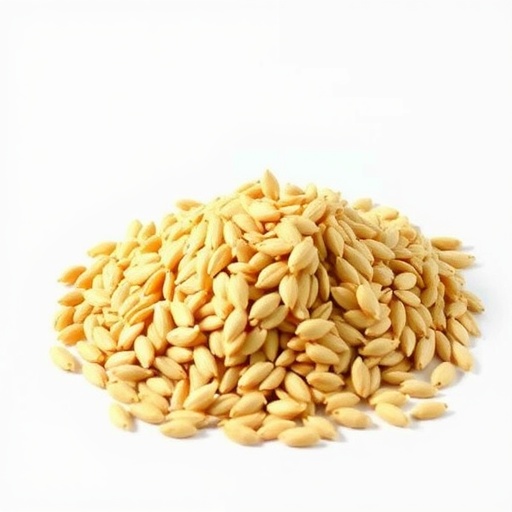In an intriguing study that has the potential to transform poultry nutrition, researchers K.B. Reda and Z.Y. Mengesha have explored the effects of processed Acacia saligna seed meal on the growth performance and carcass traits of broiler chickens. This work, poised to advance our understanding of alternative protein sources in animal feed, was published in 2025 in the journal Discover Animals. The significance of this research lies in its implications for sustainability in poultry farming, particularly concerning the ongoing global challenges associated with soybean meal reliance.
Historically, soybean meal has been a staple protein source in poultry diets, primarily due to its favorable amino acid profile. However, the rising cost of soybean and the environmental impact associated with its cultivation have prompted researchers to look for sustainable alternatives. Enter Acacia saligna, commonly known as golden wreath wattle, a leguminous tree native to Australia that has garnered attention not only for its ecological benefits but also for its nutritional properties. The global pursuit for alternative protein sources has led to the investigation of local plants that meet the dietary needs of livestock, which this study aims to address.
.adsslot_x3u15wDvdX{ width:728px !important; height:90px !important; }
@media (max-width:1199px) { .adsslot_x3u15wDvdX{ width:468px !important; height:60px !important; } }
@media (max-width:767px) { .adsslot_x3u15wDvdX{ width:320px !important; height:50px !important; } }
ADVERTISEMENT
The experimental design involved multiple groups of broiler chicks, each receiving different formulations of feed, including varying levels of processed Acacia saligna seed meal. Growth performance metrics such as weight gain, feed conversion ratio, and overall health were closely monitored throughout the study. The researchers also examined key carcass traits, including dressing percentage and organ weight, to provide a comprehensive analysis of the impact of the alternative feed.
A major outcome of the study was the observation that broilers fed with processed Acacia saligna exhibited comparable, if not superior, growth rates relative to those on a traditional soybean meal diet. These findings challenge conventional notions about feed sources and suggest that Acacia saligna may offer a sustainable solution that not only meets protein requirements but could also reduce dependency on imported feedstuffs. Additionally, the research highlighted an impressive feed conversion efficiency, indicating that the chickens were able to convert feed into body mass effectively, a crucial trait for efficient poultry farming.
Moreover, the researchers analyzed the carcass quality of the broilers, focusing on parameters such as muscle mass, fat deposition, and the overall quality of meat produced. The results showed no significant adverse effects on carcass traits from the inclusion of Acacia saligna seed meal, reinforcing the notion that this plant could be an excellent alternative in broiler diets without compromising meat quality.
Moving forward, the implications of this study cannot be overstated. With the increasing demand for poultry protein globally, finding sustainable and cost-effective feed alternatives is paramount. The successful incorporation of processed Acacia saligna seed meal could reshape poultry nutrition and farming practices, inspiring further research into other underutilized plant species. This study not only highlights a novel protein source but also serves as a clarion call for the agricultural sector to innovate and adapt in the face of environmental and economic challenges.
The research from Reda and Mengesha also opens the door for future studies investigating the biochemical properties of other legumes and their potential roles in animal nutrition. A comparative analysis of various protein sources will be essential in determining the best candidates for integration into modern poultry diets, which must balance economic feasibility with nutritional adequacy and environmental sustainability.
In summary, the exploration of processed Acacia saligna seed meal presents a significant advancement in broiler chicken nutrition research. By prioritizing local feed sources, integrating ecological principles, and maintaining focus on growth performance and meat quality, this study serves as a strong foundation for future innovations within the poultry industry.
As this research gains traction, it may well become a turning point in the ongoing effort to create sustainable agricultural practices that address both economic and environmental pressures. The poultry industry stands on the brink of change, and the work of Reda and Mengesha illuminates the path forward, ripe with opportunity for utilizing alternative feed sources that promise to enhance animal health and welfare while being mindful of our planet’s resources.
The ramifications of their findings extend beyond poultry, potentially influencing feed strategies in other livestock sectors. As researchers continue to investigate and develop plant-based alternatives, we may witness a broader shift towards regenerative agriculture, with a focus on permaculture practices that prioritize biodiversity and minimize synthetic inputs.
In conclusion, the research conducted by K.B. Reda and Z.Y. Mengesha marks a pivotal moment in the discourse surrounding animal feed innovation and sustainability. As we look to the future of agriculture, it is imperative to foster such pioneering studies that not only pave the way for practical applications but also challenge our perceptions and encourage global collaboration in pursuit of a more sustainable food system.
Subject of Research: Effects of processed Acacia saligna seed meal on the growth performance and carcass traits of broiler chickens.
Article Title: Effect of processed Acacia saligna seed meal on growth performance and carcass traits of broiler chicken as replacement for soya bean.
Article References: Reda, K.B., Mengesha, Z.Y. Effect of processed Acacia saligna seed meal on growth performance and carcass traits of broiler chicken as replacement for soya bean. Discov Anim 2, 18 (2025). https://doi.org/10.1007/s44338-025-00055-0
Image Credits: AI Generated
DOI:
Keywords: Acacia saligna, broiler chicken, poultry nutrition, alternative protein sources, sustainability.
Tags: Acacia saligna seed mealalternative protein sources for poultrybroiler chicken growth performancecarcass traits in poultryeco-friendly protein sources for livestockenvironmental impact of soybean cultivationleguminous trees in animal feednutritional benefits of Acacia salignapoultry diet innovationsresearch on sustainable animal feedsoybean meal replacement for broilerssustainable poultry nutrition





